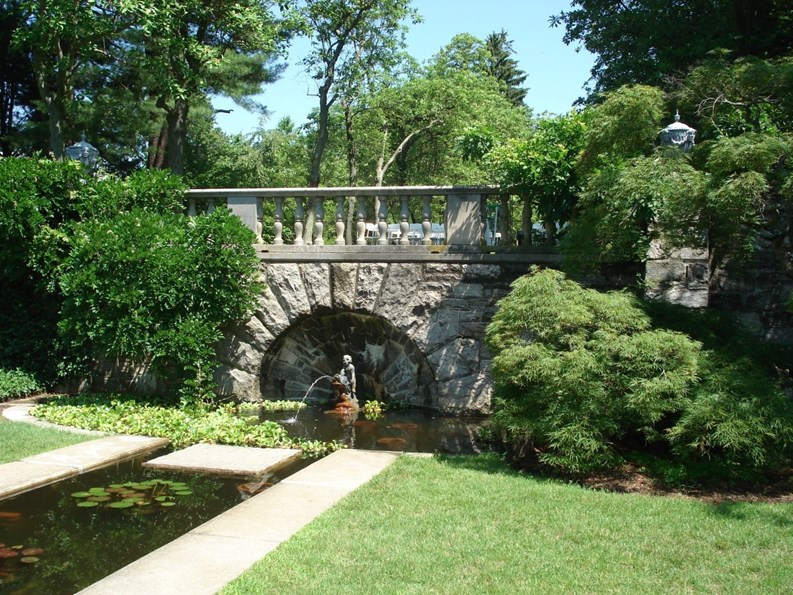If you’re looking for a lush patch of green in New Jersey, you’re in luck: the Garden State is so named because of the multitude of flora- and fauna-filled havens to choose from when you’re looking for an escape.
But one garden stands apart from the crowd, not just because of its exceptional beauty, but because the price is right for everyone. The New Jersey Botanical Garden at Skylands is the only free botanical garden in the state and offers something to see every month of the year. If you haven’t been yet, there’s simply no excuse.
History Lesson
The Botanical Garden is really only one part of a much larger parkland. The NJBG, which covers just under 100 acres, forms the heartland of a larger property that spans well over 1,000 acres in total. In the late 19th century, Francis Lynde Stetson, a corporate lawyer for J.P. Morgan, assembled the Skylands Manor. The mansion, farms, gardens, and golf courses tucked within the Ramapo Mountains supplied work to the people of the area, since the iron mines were losing momentum. Stetson named his vast country estate "Skylands Farms” and used the impressive setting to entertain friends that included the likes of Andrew Carnegie and Ethel Barrymore. Such celebrity guests were impressed with the grounds—no surprise, considering Stetson had used one of Frederick Law Olmstead’s protégés, Samuel Parsons, Jr., to design the estate.
During the roar of the 1920s, a civil engineer and stockbroker from New York City, Clarence Mackenzie Lewis, purchased the estate—and the people of New Jersey have Lewis to thank, largely, for laying the beautiful foundation of the Botanical Garden today. Lewis was a trustee on the board for the garden and felt the land should be used for showcasing the beauty of cultivated plants. During peak season, Lewis had over 60 gardeners working full-time to plant the symmetrical trees, flowers, shrubs, and plants that had been specified by prominent landscapers at the time Vitale & Gieffert. The duo had designed landscapes for Rockefeller Center, Princeton University, and grand estates on Long Island and lent their gifted hands to the NJBG, the results of which are still felt today.
Skylands was sold by to the State of New Jersey in 1966 and was deemed an official botanical garden in 1984. The New Jersey State Botanical Garden is a part of Ringwood State Park within the New Jersey Division of Parks and Forestry in the Department of Environmental Protection. Today, the NJBG appears on both the State and National Registers of Historic Places.
Behind the Greens
All those gorgeous plants on all that lovely land need a lot of attention, as one can imagine. For the Botanical Garden to maintain the beauty and livelihood, for which they’re so loved, it takes the efforts of many.
Richard Flynn, who earned his degree in Ornamental Horticulture, has been head landscape designer at the NJBG for the past eighteen years. “Along with the New Jersey Parks and Forestry and Department of Environmental Protection,” says Flynn, “I am responsible for the maintenance and upkeep of the 96 acres of Botanical Garden.” Flynn has some help, of course, but there aren’t many on staff. “I don’t work with any botanists or other landscapers,” Flynn says. “We have a small garden staff consisting of nine people who have various horticultural backgrounds.” While a small staff does contribute to the family-feel of the place and the consistency of the grounds, Flynn wouldn’t mind if there were a few more around to help during the busiest times. He cites a “lack of funding and manpower” as the biggest challenges he faces on the job. Flynn, along with a group of NJBG volunteers recently restored the beloved Annual Garden to previous owner Lewis' original design. The job wasn’t easy and, due to the nature of annuals, the job continues to be tough, requiring intensive cultivation.
Helping Hands (With Green Thumbs)
Because state-run parks are at the mercy of that year’s state funds, the NJBG relies heavily on the help of support groups and volunteers. Maja Britton is the public relations liaison and member of the board of the NJBG Member Support Group. “There’s a state-paid staff that takes care of the inner-workings of the Botanical Garden,” says Britton. “Our group is a member support group licensed to be an ORFO or ‘Friends Group.’ Member dollars pay for some limited staff, but mostly it's our volunteers, who contributed over 11,000 hours of work at the Botanical Garden last year.” The group serves the Botanical Garden by being advocates, basically, for the health and well being of what they see as an exceptional state treasure. Raising money for the NJBG is one of their main goals.
"We have member dues, and people donate, and we do a lot of fund-raising activities that not only raise money, but provide great activities for guests of the Botanical Garden, too. We do a series of six concerts in the spring; in the fall we hold the Fall Harvest event; during the holidays we decorate the main house and offer open house tours. We also provide educational programs, and run the gift shop and Visitor’s Center. We field volunteers who want to get involved.”
NJBG volunteers aren’t limited to those who participate in the member support group. According to Britton, there are always bodies needed to work on the grounds themselves—and without those helpful folks, there might not be as much garden to enjoy.
“If you want to volunteer,” she says, “call the office or just show up on Wednesday mornings. There’s always something to do.” Britton says that “At the Botanical Garden, trust me, something’s blooming right now. Volunteers help by planting, weeding, etc. There are several gardens on the grounds that simply would not exist if it weren’t for the help of volunteers.”
Beauty in the Details
Speaking of those gardens, if you’ve got a favorite flower, you’ll surely be able to find it—and if you’re easy to please, you’ll be dazzled by the array. Those with a fondness for daffodils will be thrilled with the Summer Garden. This lovely, smaller garden originally yielded roses each year, but the roses became difficult to maintain as a result of other plantings surrounding the garden. Daylilies replaced the roses, and the garden’s website promises that the lilies “put on a colorful show during the summer months.”
Hosta fans will be dazzled by the Rhododendron Garden, which volunteers and staffers say look best at the end of spring into the early summer (late May into June.) The miniature to big rhododendrons and hostas miniature boast hues of blue, green, white, and golden-colored foliage. An impressive collection of mature rhododendrons and azaleas surround the garden, too.
The main house, as Britton noted, is festooned for the holidays, but wintertime isn’t the only time to take a look. Stetson’s original mansion was demolished by Lewis in the 1920s, who built a Tudor-style house that is open for viewing. Thirty outbuildings still dot the grounds and provide more scenic enjoyment for guests.
And there’s more blooming than the flowers right now at the gardens. “We recently brought in a curator, and we’re working to renovate the carriage house right now, which serves as Visitor’s Center,” says Britton, though she notes that, like some plants, growing and adapting can take a long time. “Since the garden is preserved as a historical landmark, we have to preserve the historical nature of the site,” she says. “The plans to improve the carriage house must be approved by the state—it takes time.”
"Our focus is on the restoration of garden areas that have been neglected over the years,” says Flynn, of the landscapers on staff. “We have records from the 1930’s and our goal is to try to replicate the gardens that existed long ago.”
Flowering Possibilities
Skylands is a place where the sights, smells, and sounds of the country can be felt just minutes from the hustle and bustle—and prices—of the city. According to Britton, one of the reasons to visit the Botanical Garden is the price.
“Most gardens charge admission to get in—being a part of the state park system, we don’t. There’s a slight parking fee on some days. There is a $5 per car state park parking fee on summer weekends (Saturdays and Sundays) and all holidays through Labor Day. Parking is free on summer weekdays and throughout the winter, spring and fall. With four people in the car, it’s next to nothing to enjoy a day here. Individuals and families can play, walk in the woods, enjoy the scenery, and view the flowers. In this densely populated part of the country, many people have very small backyards or no backyards at all. It’s very important to maintain open green spaces that everyone can enjoy.”
People come to NJBG for not only the scenic respite but also for tours and music. On July 10th, Linda Ipanema & the Dixie Cats will play, followed on July 24 by the 3M Band; and August 7, Bob Leive, Lou Pallo and Patti Rio, and August 21 by Brassworks. NJBG/Skylands is located off Morris Road in Ringwood, New Jersey. For an event schedule, membership brochure, directions or more information, call 973-962-9534 or visit www.njbg.org.
Mary Fons is a freelance writer and a frequent contributor to The New Jersey Cooperator.







Leave a Comment